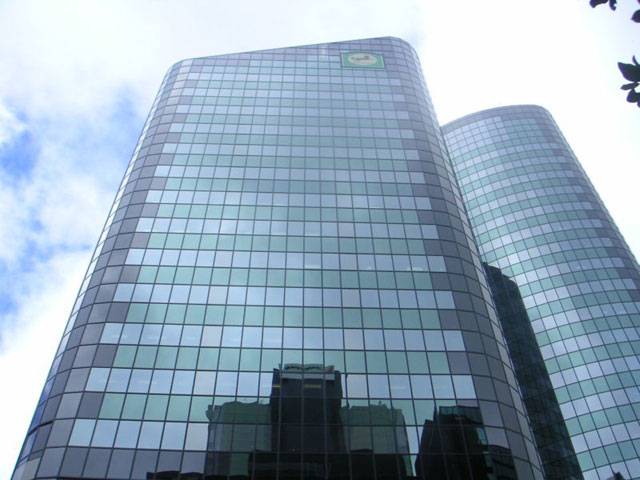KARACHI - The country’s Gross Domestic Product (GDP) grew by five per cent during the first quarter of the current fiscal year as compared to the previous fiscal year, beating the target and almost doubling the figure for the same period last year.
The State Bank of Pakistan released its first quarterly report for the financial year 2014 (FY14) on the state of economy on Friday.
The SBP data for the early months of the financial year began in July 2013 said GDP grew by 5.0 percent, compared with only 2.9 percent in the first quarter of the last fiscal year.
"Since the macroeconomic indicators were favourable at the start of the year, the increase in real GDP growth in fiscal year 2014 was discernible," the bank said.
According to the report, a GDP growth of 4.4 per cent is the target for the full year 2014. The upbeat first quarter performance came on the back of good performances by the industrial and services sectors, the report said.
However the bank warned that inflation swelled to 8.1 percent in the first quarter compared with 5.6 percent in the corresponding period last year.
The report says that since macroeconomic indicators were favourable at the start of the year, the increase in real GDP growth in FY14 was discernible. Industry and services were the major drivers of growth as agriculture performed below target.
The report suggests that in order to maintain the current growth momentum and take the economy to a higher growth trajectory, the government should speed up structural reforms in the fiscal and energy sectors. By focusing on these sectors, the government has signaled that its priorities are correct. It urges the government to sustainably manage longstanding issues which have kept growth below potential.
As the industrial sector was revived, import pressures reappeared, especially for capital goods and raw materials. The import of petroleum, machinery and metal was particularly strong, which increased the trade deficit by US$ 0.6 billion during the first quarter of FY14 as compared to the first quarter of FY13. Additional stress on the current account came from delayed inflows of coalition support fund (CSF) in the first quarter of FY14. As a result, the current account posted a deficit of US$ 1.2 billion against a surplus of US$ 0.4 billion in the first quarter of the previous year. Although workers’ remittances posted an impressive 9.1 percent growth, this was not enough to cover the forex gap in other heads.
The report said that repayments on external debt continued to exceed fresh disbursements while foreign investment remained shy. This caused a strain on the country’s FX reserves, which posted a decline of US$ 1.2 billion during the quarter.
As a result, the PKR depreciated by 6.0 percent against the US dollar during Q1-FY14, compared to only 0.3 percent in the first quarter of the previous year.
The report pointed out that headline CPI inflation increased to 8.1 percent in Q1-FY14, compared to only 5.6 percent in the preceding quarter. SBP increased its policy rate by 50 bps to 9.5 percent in the monetary policy decision announced in September 2013 to rein in the second-round effect of food inflation, curb inflation expectations and to counter market sentiments following the volatile PKR.
The government could not meet the limit of zero quarterly borrowing from SBP though its borrowings were well below the limit agreed with the IMF.
The fiscal deficit fell to 1.1 percent of GDP in Q1-FY14 from 1.2 percent in the corresponding quarter last year. This improvement occurred on both the revenue and expenditure sides. On the revenue side, it was the increase in tax rates and not the base which is responsible for higher collection during the quarter. Non-tax collections were also high due to certain one-off revenues. On the expenditure side, a major positive was the reduction in interest payments, following the interest rate cuts in FY13.
The report said that public debt posted a record increase of Rs 1.0 trillion during the quarter. This increase, however, does not represent the fiscal imbalances alone, which recorded only a modest increase. Instead, this increase can primarily be traced to large revaluation losses associated with the external debt stock due to adverse exchange rate movements during the period. According to the report, there is a corresponding need to rebalance the maturity profile of Pakistan’s domestic debt. The growing prominence of 3-month instruments in the outstanding volume of T-bills requires attention because this exposes the financial system to interest rate and roll-over risks.
The IMF approved a $6.7 billion bailout loan package for Pakistan in September last year to help the country achieve economic reforms, particularly in its troubled energy sector. The fund also observed that Pakistan's economy was picking up.
Tuesday, April 16, 2024
Economy beats growth target, up by 5pc: SBP
| Warns inflation swelling | Import pressure raises trade deficit by $0.6 billion | Workers’ remittances witness 9.1pc surge

Caption: Economy beats growth target, up by 5pc: SBP
Decision to retaliate against Iran attacks rests with Israel, says Pentagon
1:05 PM | April 16, 2024
Elon Musk proposes small fee for new X users to combat fake accounts
1:01 PM | April 16, 2024
Samsung overtakes Apple as top smartphone maker: Report
12:57 PM | April 16, 2024
Global brands facing challenge from local contenders in Pakistan's FMCG market
10:24 AM | April 16, 2024
Israeli Air Force finalizes preparations for possible attack on Iran
8:21 AM | April 16, 2024
Political Reconciliation
April 16, 2024
Pricing Pressures
April 16, 2024
Western Hypocrisy
April 16, 2024
Policing Reforms
April 15, 2024
Storm Safety
April 15, 2024
Democratic harmony
April 16, 2024
Digital dilemma
April 16, 2024
Classroom crisis
April 16, 2024
Bridging gaps
April 16, 2024
Suicide awareness
April 15, 2024
ePaper - Nawaiwaqt
Advertisement
Nawaiwaqt Group | Copyright © 2024





